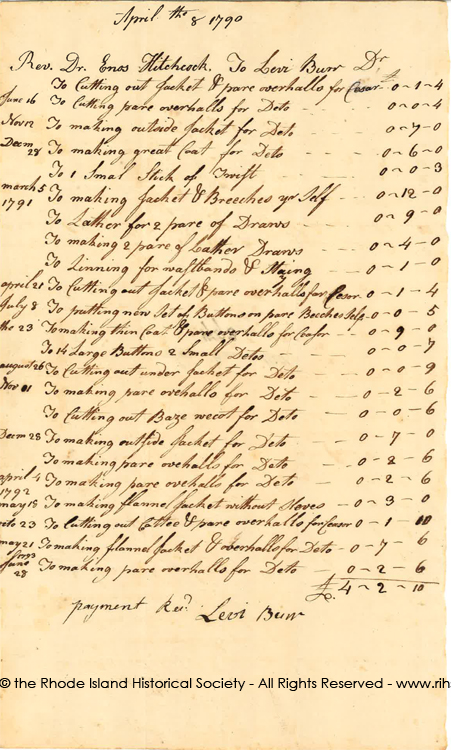
In going through the Enos Hitchcock papers, I found an account with Levi Burr of Providence, who was apparently a tailor who made and repaired clothes for both the Reverend and Ceasar Hitchcock.
In 1790, Ceasar (here Cesar) appears to have received a jacket, an outside jacket, a greatcoat and two pairs of overhalls. The “jackets” may be what we now think of as sleeved waistcoats, while a greatcoat is a heavy overcoat. (Burr might have cut out some garments that were assembled by someone else, who was skilled at sewing, but not at cutting out. Taking a clients measure and successfully cutting out a garment is an art learned during multi-year apprenticeships, and not every apprentice successfully learned those skills. A firm, fine seam is an easier skill to acquire.)
In 1791, Reverend Hitchcock had Burr make him a jacket and breeches, probably of fine black broadcloth, but perhaps of black silk Florentine. While it is not clear for whom the leather drawers were made, it is likely they were made for Ceasar. Leather breeches were durable workingmen’s wear, and were even issued to Continental troops during the war.
Ceasar does receive four pairs of overalls (one spare), a jacket, a “thin coat,” possibly an unlined linen coat, an underjacket (perhaps, again, what we think of a sleeved waistcoat), an outside jacket (like a frock coat, but perhaps shorter) and a baize (woolen) waistcoat. That’s four or five lower-body garments, plus three jackets or coats, one piece of outerwear, and a waistcoat.
In 1792, the tally is similar: three pair of overalls, two flannel jackets, and a coatee. There is yet another pair of overalls in 1793.
Did Ceasar wear out his clothes? There are numerous bills for shoes and shoe repair for Ceasar in Hitchcock’s papers, suggesting not only that Ceasar worked hard and wore out his clothes but also that he had spare clothes—indeed, Burr makes him “Spare Overhalls.” While we can but guess at the cut and color of Ceasar’s clothes, Burr’s account to Hitchcock help give us a sense not just of what Ceasar had, but of how hard he wore those clothes by how often the needed more.
~Kirsten Hammerstrom, Director of Collections
